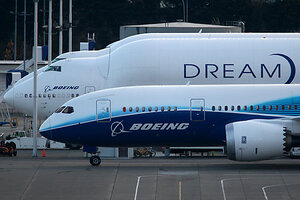Boeing 787 Dreamliner poised for first flight
Boeing's 787 Dreamliner is set to attempt its first flight Tuesday after years of delays. The company's first new jetliner in almost 15 years, the plane is made of lightweight composite materials and supposed to reduce fuel costs by 20 percent.

Boeing's 787 Dreamliner, front, rolls past the Dreamlifter, a modified 747, during taxi tests on Dec. 12, at Paine Field in Everett, Washington.
Joshua Trujillo/Seattle Post-Intelligencer/AP
After two years of delays, Boeing’s newest commercial aircraft – the 787 Dreamliner – is scheduled to make its first test flight Tuesday afternoon.
If everything goes as planned, the new airliner will be a major accomplishment for Boeing, which has been having labor and supply issues. It’s Boeing’s first all-new jet in nearly 15 years.
As the first airliner to be constructed mainly of lightweight composite materials – carbon and titanium – the 787 also sets the pace for the next generation of more efficient commercial aircraft.
“It’s more environmentally friendly, it’s more efficient, uses less fuel, it’s going to cost the operator less to fly, it’s going to allow the passengers to pay less and feel better when they land,” Jim Albaugh, Boeing executive vice president and CEO, told CNN Monday.
Boeing claims the new design, in which it has invested some $10 billion, can save as much as 20 percent in fuel costs. It’s also designed to produce fewer emissions. Rival Airbus is also developing an airliner made mostly from composite materials – the A350.
Although behind schedule, Boeing has some 850 orders for the $150 million Dreamliner. Following its first test flight from Boeing’s facility near Seattle, the 787 is scheduled to undergo months of intensive flight testing before making its first delivery to Japan’s All Nippon Airlines about a year from now.
Given earlier delays – the first test flight was postponed six times – and the aircraft’s unique design, some analysts think it could be longer than that before passengers begin boarding the 787.
"This is a new aircraft and a new way of building aircraft," Richard Aboulafia, aerospace analyst at research firm Teal Group, told Reuters. "Twelve months (of testing) is the best-case scenario. More time is desirable."
“Just as they found hurdles on the way to first flight, they are going to find hurdles on the way to certification," Mr. Aboulafia said, referring to Federal Aviation Administration (FAA) approval.
So far, according to Boeing, ground tests have gone well. That included a high-speed taxi run Monday in which pilots accelerated to 130 knots, lifting the nose gear of the aircraft off the runway before decelerating.
“Our pilots told me the airplane performed beautifully," Michael Delaney, vice president and chief project engineer for the 787, said in a statement. "We're going through and analyzing the data to ensure we're ready for first flight. From evaluations we've done so far, everything looks good."
The 787 being tested Tuesday is designed to carry 250 passengers as far as 9,000 miles. A stretch version will be able to carry 290 passengers and a short-range model up to 330.
The Seattle area, which has seen economic ups and downs over the years, appears to be enthusiastic about this new symbol of an industry long associated with the Puget Sound. The Seattle Times waxed lyrical in its lead editorial Tuesday:
“This is Washington's airplane.
We might call it the Pacific Northwest's biggest industrial gamble, except that ‘gamble’ is an unfair word. Gambling is the taking of risks for fun, and that's not the spirit of this airplane at all. Every bolt, panel, wire and chip in it has been proposed, reviewed, modeled, priced, contracted, tracked, assembled and inspected.
“…. The Dreamliner is also an economic risk, though we don't think the risk is as big as it looks. Customers are clamoring to get their hands on it. The remaining risk is mostly how smoothly the company can assemble it — a thing it had better not mess up.
But that is a thought for later. Today we think only of the plane, and its wanting to fly.”
---
Follow us on Twitter.
